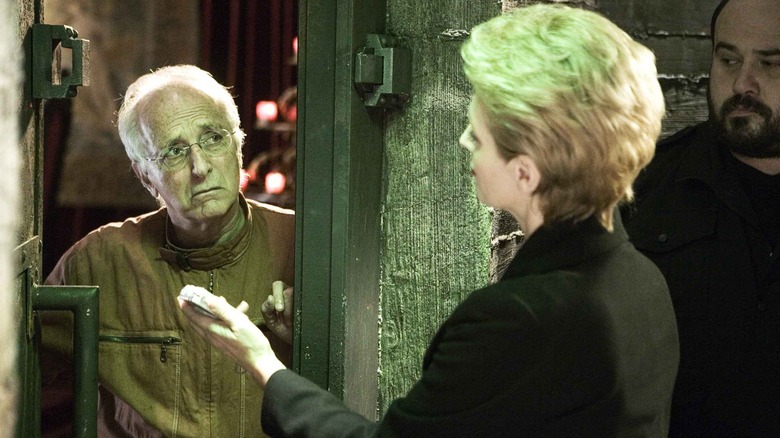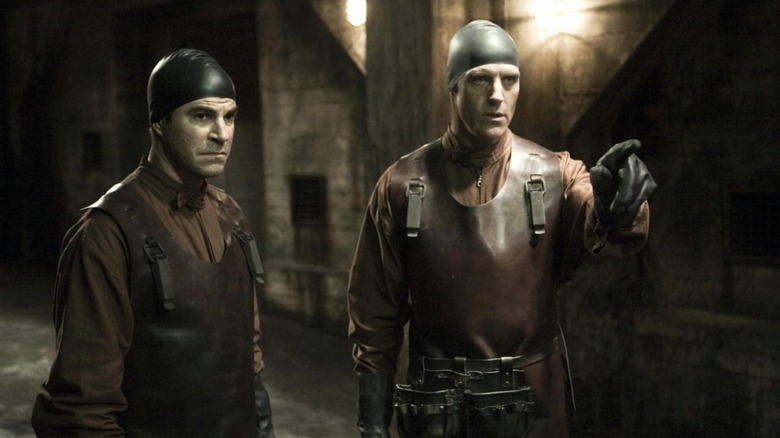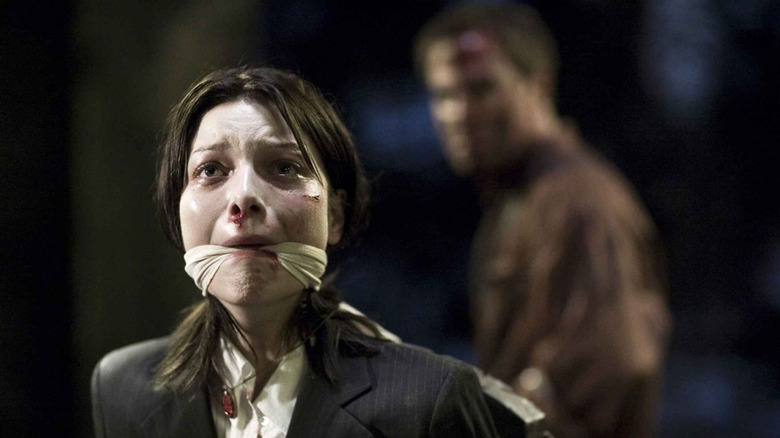The Cannibal Holocaust Cameo You May Not Have Noticed In Hostel: Part II
The publication of Richard Connell's short story "The Most Dangerous Game" in January 1924 sparked a wave of urban legends that persist to this day. The legend goes that the ultra-wealthy — bored with financial conquest, and having exhausted all ordinary forms of entertainment — are now using their bottomless wealth and said wealth's subsequent insulation from moral and legal consequence to indulge in the darkest impulses of humankind. It's easy for those who are not ultra-wealthy to imagine being kidnapped — or hired — for a rich maniac's hunting excursion. Or being enlisted in a twisted game of Would You Rather? Or, in the case of Eli Roth's two "Hostel" movies, abducted and sold into an underground torture factory called The Elite Hunting Club where the wealthy are allowed to inflict every depraved, sadistic desire they want on hapless young tourists.
The "Hostel" movies came at a time in horror movie history when "torture porn" was emerging as a dominant genre; That is: Horror films that centered on bodily torture as a central plot element, and spent a good deal of running time on the visceral, bodily dismemberment of its protagonists. Some critics have pointed out that the genre was a reaction to the real-life horrors of 9/11, and the subsequent wars and malfeasance committed by the American military. It's certainly no coincidence that the first "Saw" film hit theaters one year after the release of the infamous torture pictures from Abu Ghraib. Torture was everywhere in popular entertainment during the early days of The War on Terror. Mix that torture obsession with the above-mentioned — and ongoing — suspicion that the ultra-wealthy might be hunting the lower classes for sport, and you have a ready-to-go film franchise directed by a deep-cut gore enthusiast.
Eli Roth loves gore
It's no secret that director Eli Roth loves blood and guts. Roth has a raunchy, shocking sense of humor, and was raised watching the nastiest films the 1970s had to offer, including "The Texas Chainsaw Massacre" and "The Last House on the Left." When he began directing films in 2002, he started with a cabin-bound disease film called "Cabin Fever" wherein a group of attractive twentysomethings travel to a remote cabin where they contract a disease that causes them to melt into puddles of scab soup. Roth followed that with the "Hostel" in 2005 and "Hostel: Part II" 2007.
While even the most casual cineaste can see the 1970s gore film influence on Roth's oeuvre, Roth sort of gave the game away in 2013 when he made "The Green Inferno," a loving tribute to cannibal films of the past. Not only was "The Green Inferno" clearly inspired by the likes of Umberto Lenzi's "Cannibal Ferox," Jesus Franco's "Mondo Cannibale," Sergio Martino's "The Mountain of the Cannibal God," and, most openly, Ruggero Deodato's 1980 cult classic "Cannibal Holocaust," one of the goriest movies ever made. Indeed, "The Green Inferno" takes its title from a film-within-a-film seen in "Cannibal Holocaust." Roth liked these movies so much — and was so keen to let audiences know that he was inspired by them — that he included a series of "additional reading" credits at the end of "The Green Inferno," encouraging enterprising gorehounds to seek them out.
The making of "The Green Inferno" also, retroactively, pointed out a notable cameo in "Hotsel: Part II": That of Ruggero Deodato himself.
Ruggero Deodato
In "Hostel: Part II," there is a scene wherein a potential victim is being "shopped" to the ultra-wealthy maniacs currently up to their torturous shenanigans in their own little agony booths. A manager of The Elite Hunting Club knocks on a door and offers a victim to a greying Italian man in a jumpsuit. He demurs for the moment as he is, we soon learn, in the midst of slicing pieces off a conscious victim's leg, and carrying the pieces to a small table for *ulp* a meal. That aging Italian is none other than Ruggeo Deodato himself.
In 2007, the casting of Deodato was merely a cute wink to horror fans: The Italian cannibal character is played by the director of one of the world's most notorious cannibal movies. After "The Green Inferno," the kinship between Roth and Deodato, now 82, was made explicit.
Deodato himself was no mere gorehound, however. Deodato's directing career stretches back to the 1960s, and covers a wide variety of Italian exploitation movies, including erotic thrillers ("Waves of Lust"), peplum films ("Hercules, Prisoner of Evil"), poliziotteschi ("Live Like a Cop, Die Like a Man"), action thrillers ("Concorde Affaire '79"), and sci-fi ("Raiders of Atlantis"). "Cannibal Holocaust" became Deodato's most notorious not only for its extensive use of gore (paired with actual on-camera animal death), but its documentary style — it's often cited as one of the first found-footage horror films. The film was notoriously banned, and Deodato was arrested under suspicion of making a snuff film. Deodato had to prove to the court that his film was indeed manufactured, and was forced to produce the actors in question to prove they were not dead.
Eli Roth, clearly a disciple of Deodato, wanted to pay him homage. Depicting him eating a human leg seemed perfectly appropriate.


